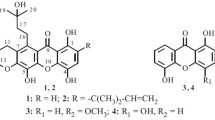Abstract
The results of qualitative and quantitative determination of anthraquinones in Indian madder (Rubia cordifolia L.) cell culture are presented. According to the 1H and 13C NMR, UV, IR, and mass-spectroscopic data, seven anthraquinones have been identified, in which munjistin and purpurin are predominant. The cell culture preparation exhibits antiinflammatory activity, which is manifested by an antiexudative effect and antiproliferative action during the rapid development of a model edema. Adecrease in the antioxidant state without significant suppression of enzymatic activity is demonstrated.
Similar content being viewed by others
References
G. C. H. Derksen and T. A. van Beek, in: Studies in Natural Product Chemistry, Rubia tinctorum L., Atta-ur-Rahman (ed.), Elsevier, Amsterdam (2002), p. 629.
A. H. Gilani and K. H. Janbaz, Phytother. Res., 9, 372–375 (1995).
N. P. Mischenko, S. A. Fedoreyev, V. P. Glazunov, et al., Fitoterapia, 70, 552–557 (1999).
H. Itokawa, K. Mihara, and K. Takeya, Chem. Pharm. Bull., 31(7), 2353–2358 (1983).
R. A. Muzychkina, Natural Anthraquinones. Biological Properties and Physicochemicals Characteristics, G. A. Tolstikov (ed.), PHASIS, Moscow (1998).
A Practical Guide on the Experimental (Preclinical) Investigation of New Pharmaceuticals [in Russian], Pharmacological Committee of the USSR Ministry of Public Health, Moscow (2000)
V. M. Bryukhanov, Ya. F. Zverev, Ya. S. Arbuzov, et al., Ros. Fiziol. Zh. im. I. M. Sechenova, 90(8), 35–36 (2004).
K. Sato, T. Yamazaki, E. Okuyama, et al., Phytochemistry, 30(5), 1507–1509 (1991).
G. C. H. Derksen, T. A. van Beek, A. Groot, and A. Capelle, J. Chromatogr., 816, 277–281 (1998).
I. N. Kuzovkina, O. V. Mantrova, I. E. Al’terman, et al., Fiziol. Rast., 43(2), 291–298 (1996).
P. Banyai, I. N. Kuzovkina, L. Kursinszki, and E. Szoke, Chromatographia, 63, (Supp. 13), S111–S114 (2006).
G. Ya. Shvarts and R. D. Syubaev, Farmakol. Toksikol., 45(1), 46–49 (1982).
Author information
Authors and Affiliations
Additional information
__________
Translated from Khimiko-Farmatsevticheskii Zhurnal, Vol. 41, No. 11, pp. 38–41, November, 2007.
Rights and permissions
About this article
Cite this article
Mishchenko, N.P., Fedoreev, S.A., Bryukhanov, V.M. et al. Chemical composition and pharmacological activity of anthraquinones from Rubia cordifolia cell culture. Pharm Chem J 41, 605–609 (2007). https://doi.org/10.1007/s11094-008-0021-1
Received:
Published:
Issue Date:
DOI: https://doi.org/10.1007/s11094-008-0021-1




